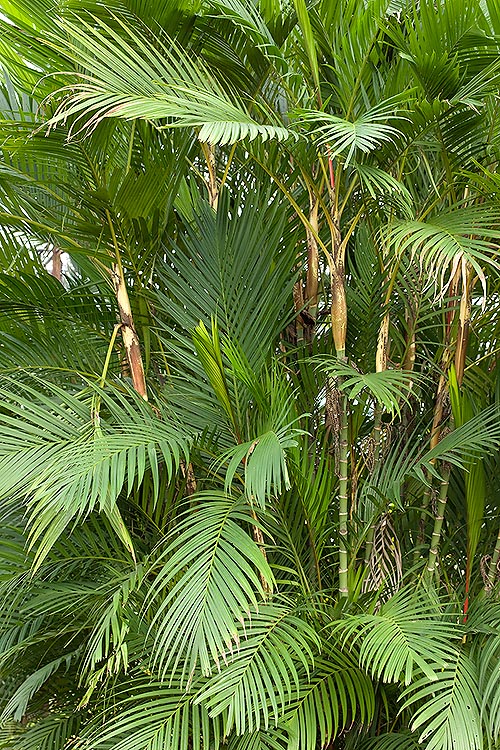Family : Arecaceae

Text © Pietro Puccio

English translation by Mario Beltramini

The Pinanga adangensis, caespitose, 4 m tall, is very decorative also at home © Giuseppe Mazza
This plant is native to peninsular Malaysia and Thailand, where it grows in the humid forests along the bank of the water streams up to about 200 m of altitude.
The name of the genus is the Latinization of the Malaysian name ‘pinang’.
The Latin name of the species, “adangensis” = of Adang, refers to one of its places of origin, the island of Adang, along the Thai coasts.
Common names: ivory crown (English); mak adang (Thai).
The Pinanga adangensis Ridl. (1912) is a monoeicious plant, caespitose, with up to 4 m tall stems with a diameter of 3-4 cm, smooth and green, on which are evident the rings, trace of the junction of the fallen leaves.
The leaves are pinnate, up to 2 m long on a 30 cm long petiole, with intense green pinnnulae, regularly distributed along the rachis, 50 cm long and up to 4 cm broad, linear with sharp apex, but the terminal pinnulae having the apex truncated and toothed. The petiole of the emerging leaf is initially of reddish colour. The basal sheath of the leaf, of cream yellow colour and covered by a brown tomentum, wraps entirely the stem for a length of about 50 cm. The inflorescences are ramified, up to 50 cm long, and bear under the leaves. The fruits are ovoid, about 1,6 cm long, of blackish purple colour when ripe, distributed in two opposite rows. It reproduces by seed and by division.
Plant of remarkable ornamental effect, but still little known, is utilizable in the zones with tropical and subtropical climate in shaded position and in fertile soils constantly humid, even if, when adult, it may resist to short dry periods. It is rather sensitive to the low temperatures as it may stand, rarely and only for a very short period, temperatures close to 0 °C. It is cultivable also in pot for the decoration of interiors, utilizing substrata rich of organic substance with addition of coarse sand or agriperlite, around the 30%, for improving its drainage, and with temperatures which is good to keep always over the 14-16 °C.
→ For general notions about ARECACEAE please click here.
